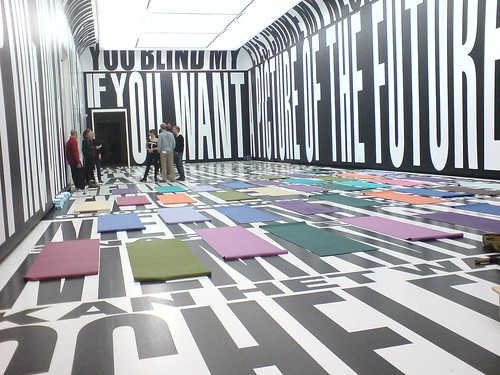The last time we were in Holland for a Museum Night, it was in Rotterdam, and it was an infuriating mess. All the museums in the city stay open until 2AM and program special activities and events. In 2005, that included an impromptu drum circle on and around some large Donald Judd sculptures in an unattended wing of the Museum Boijmans Van Beuningen. When the one guard I finally found wouldn't do anything to stop it, I went to the front desk and demanded to see the director--who showed up, and finally closed the lower floor.
So yeah, a bit incredulous, but Museumnacht Amsterdam turned out alright. We started at the Temporary Stedelijk, which had, not guards, but actual bouncers at the door, so it stayed very civilized the whole time we were there. They're in the second half of a major construction project, so the renovated galleries were sparsely populated by works that didn't need much, if any conservation or climate control. And many of the galleries were just plain empty.
And it was utterly fantastic. It felt like having the entire museum to yourself.
The ersatz yoga studio in Barbara Kruger's installation was amusing, but the most interesting thing was a performance by members of the contemporary chamber orchestra, Ives Ensemble, of a 1987 John Cage piece, Music For...(1984-87). The composition, for "variable chamber ensemble," has parts for up to 17 instruments [each titled, Music For _Clarinet_, _Violin_, &c.] and can be performed by from one to seventeen musicians, who are to be scattered throughout a space.
It was created for an ensemble in Pittsburgh, but I didn't write down the details from the score, figuring [wrongly] that I'd be able to find out more online.
Anyway, the performers--there were six in the version we saw, and they said another member of the ensemble would join them for the two later performances--synchronized their stopwatches while standing on the dais for On Kawara's One Million Years A.D. [which was off, the empty seats making me think about hopping up there ourselves and just rattling off numbers, for fun], and then they hustled off to find their rooms.
There were a couple of doorways where you could see two performers at once, but mostly, you'd see one, and hear a couple of others bleeding through. We did about three laps of the piece in around 30 minutes. There were probably a couple of dozen active listeners scattered about, and then another couple of dozen folks who we only saw once.
I was initially skeptical of the National Gallery's decision to play Morton Feldman's Rothko Chapel in their all-black Rothko installation in the Tower Gallery, but I quickly softened, and the last two times I've been there, it's been a transformative pleasure to be all alone in that space for 20-30 minutes at a time.
Hearing Cage's work filter through a museum was equally rewarding, and it made me want to experience more of it. I spoke with a few musicians afterward, and they were practically giddy; it was apparently a surprising and fascinating experience for them, too. Which means it's rarer than museum yoga.















